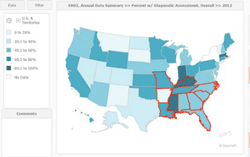Hearing Loss Data: 3 Insights
 Learn how CDC EHDI is taking a leading role in the collection of quality data.
Learn how CDC EHDI is taking a leading role in the collection of quality data.
The Early Hearing Detection and Intervention (EHDI) program at CDC is leading the national effort to collect quality data on deaf and hard of hearing (D/HH) babies and very young children. Quality data means that it is complete, timely and accurate and can help state and territorial programs ensure all D/HH babies are identified early and receive intervention services. CDC is doing this by supporting efforts to standardize the collection, analysis, and reporting of EHDI data so that it is comparable between states and territories, and is accurate.
1. Interactive Data Encourage Use of Findings
CDC developed a data query tool called the EHDI Data Analysis and Statistical Hub (DASH). EHDI DASH is an online, interactive data dashboard that uses maps, bar charts, and graphs to show key indicators for states and territories, such as the percent of babies who received a hearing screening or diagnostic testing.

EHDI DASH is an interactive website, so you can select different combinations and charts to show specific data by year and highlight possible correlations to explore further.
EHDI DASH allows users to create interactive summaries of data from the annual CDC Hearing Screening and Follow-Up Survey (HSFS), including comparisons between states and territories and trends for babies being screened for and diagnosed as D/HH, and those that are enrolled in early intervention.
For example, EHDI DASH can show the increase in the number of D/HH babies being identified early in each state between 2006 and 2013.
2. Standardized Data Can Be Tracked over Time and Show Progress
Without standardization across programs, it is difficult to know the true number of D/HH babies who are not receiving recommended follow-up services. In response, the CDC and its partners are involved in a number of efforts to strengthen the collection, analysis, and reporting of standardized data.
Collaboration with partners is key to creating and adopting tools to collect standardized data. The CDC program convened the EHDI Functional Standard Working Group, which included state program staff; this collaborative effort created the EHDI Information System (EHDI-IS) Functional Standards in 2015. These standards provide states and territories with:
- Guidance on the technical and functional requirements that a complete EHDI-IS should meet in relation to monitoring; and
- The operational, programmatic, and technical criteria that all state EHDI programs should implement during the process of developing, using, and evaluating an EHDI-IS.
Having an EHDI-IS that meets these requirements helps states collect, use, and provide better and comparable data. That in turn helps enhance each state’s EHDI program and the delivery of services to babies. For more information on the EHDI-IS Functional Standards, visit EHDI-IS Functional Standards.

Before one month of age: hearing screening. Before three months of age: hearing evaluation. Before six months of age: early intervention.
3. Information Technology Connects Clinical Records and Public Health Data Systems
CDC EHDI is working at the forefront of health information technology to help connect public health and clinical services. It seeks to improve the standardization and reporting of hearing screening results and demographic data (such as maternal race, ethnicity, and education). As part of this effort the CDC is coordinating with national and international organizations on standards for improved communication and health information exchange (interoperability) between electronic health records in hospitals and clinics, and public health information systems.
In particular, CDC is:
- Establishing national standards on information exchange and measures of electronic quality (eMeasures);
- Promoting the use of those standards to support data exchange with electronic health records; and
- Developing standards-based tools that help coordinate services so as to ensure that babies found to be D/HH receive recommended follow-up.
This activity improves how data are collected, analyzed, reported and used to help ensure that all D/HH babies are identified early and receive timely services. For more information on interoperability and health information exchange please visit EHDI Electronic Health Records Technology.
Real World Success Follows Attention to Detail
To help increase the standardization of data across programs, the CDC has made several updates to its annual HSFS since its inception in 2007. One example is the updated definition for “In-Process,” which is used to report data about the few cases where a baby needs more tests before a diagnosis can be made. At first, the definition for this data item was not very specific, and babies that had not received any diagnostic testing were being reported in this field. This led to a lack of standardization with the data, and a higher than expected number of babies reported as being “In-Process.”
In response, the CDC revised the definition for this data item to make it more specific and easier to understand. The change has improved comparability of the information for this data item, such that the percent of babies reported as “In-Process” is down from 16.0% in 2006 to 1.8% in 2013. Other updates to the survey are making it possible for more accurate assessments of how many babies are not receiving recommended follow-up services due to specific reasons, such as parents or guardians not responding to reminders to seek recommended services.
- Page last reviewed: May 10, 2016
- Page last updated: May 10, 2016
- Content source:
- National Center on Birth Defects and Developmental Disabilities
- Page maintained by: Office of the Associate Director for Communication, Digital Media Branch, Division of Public Affairs




 ShareCompartir
ShareCompartir